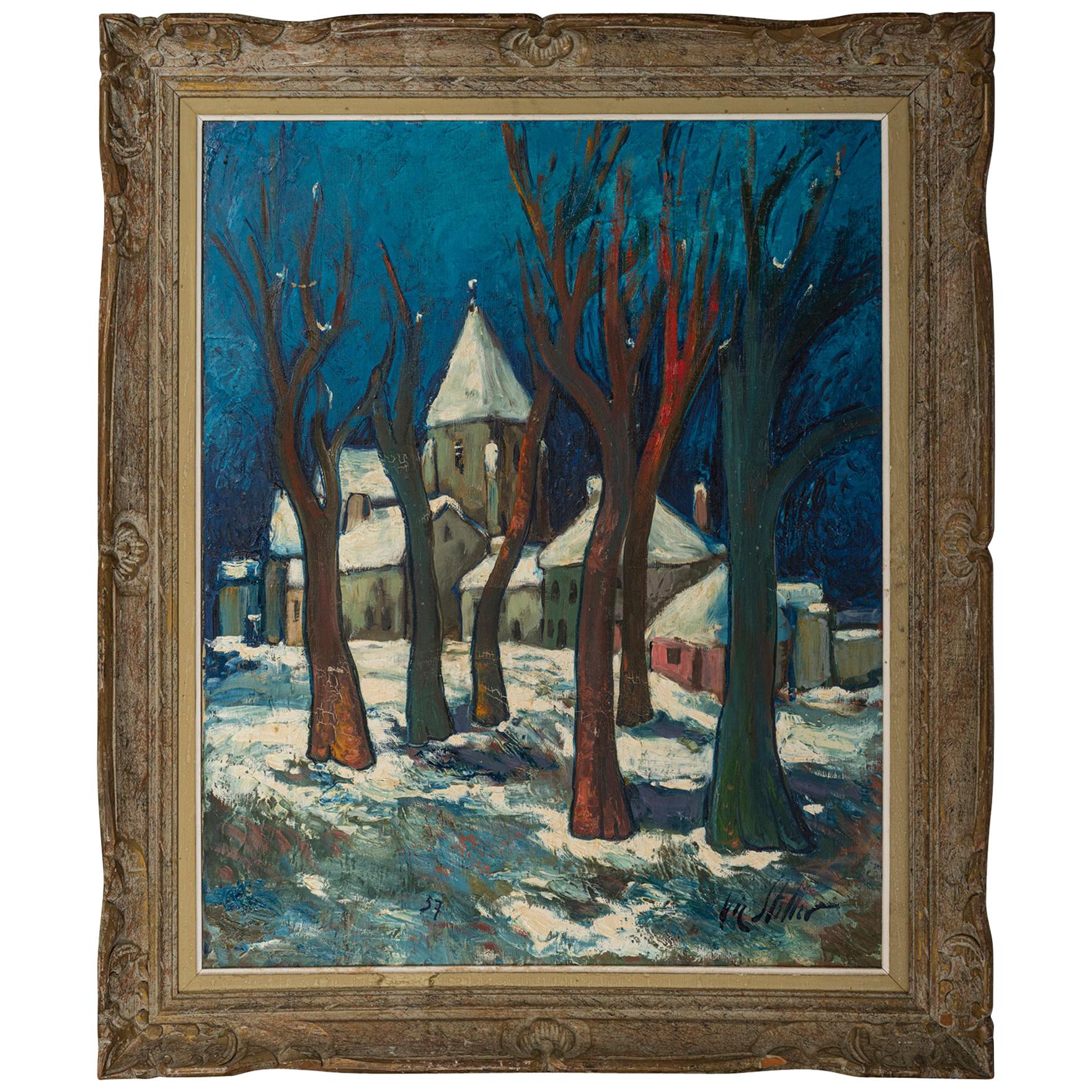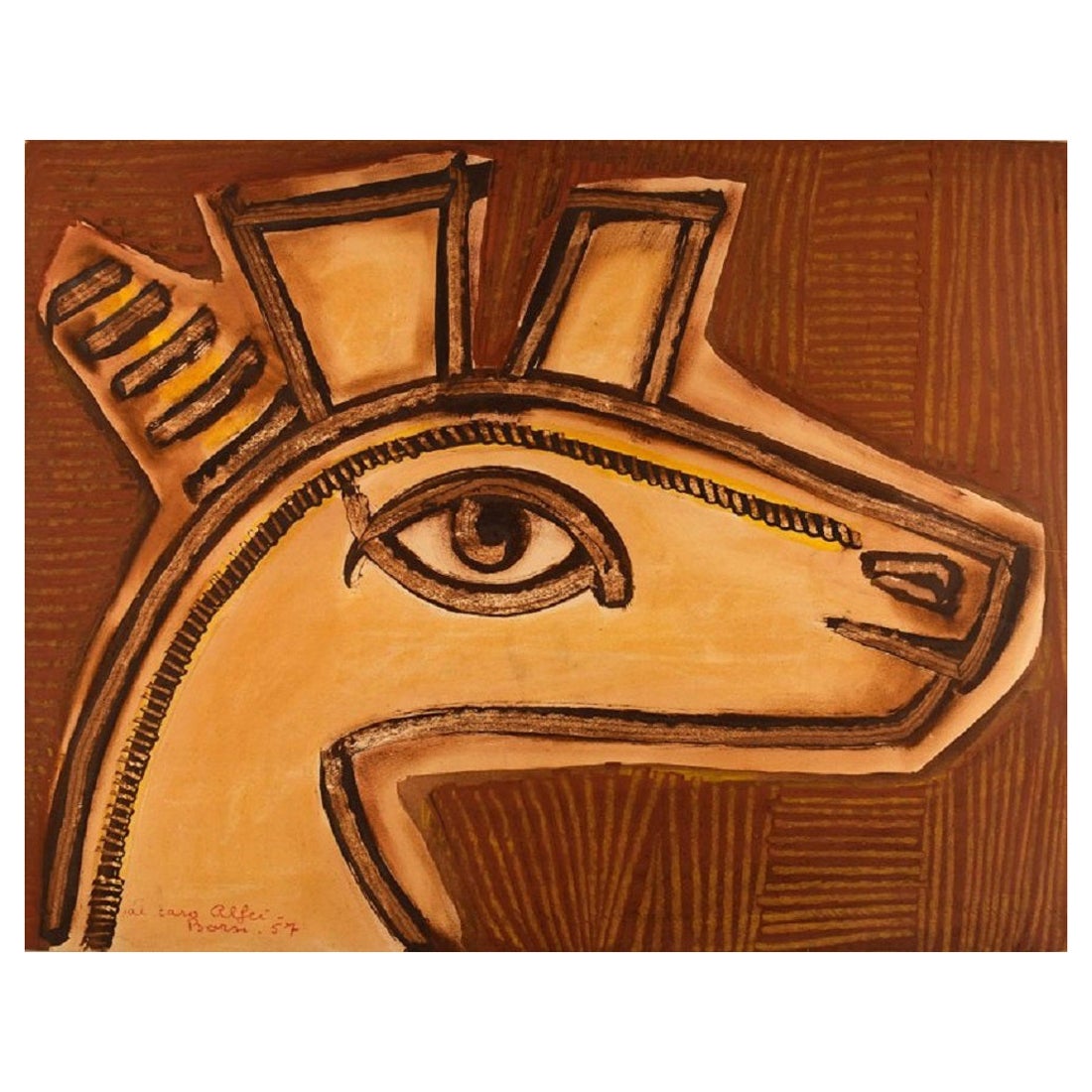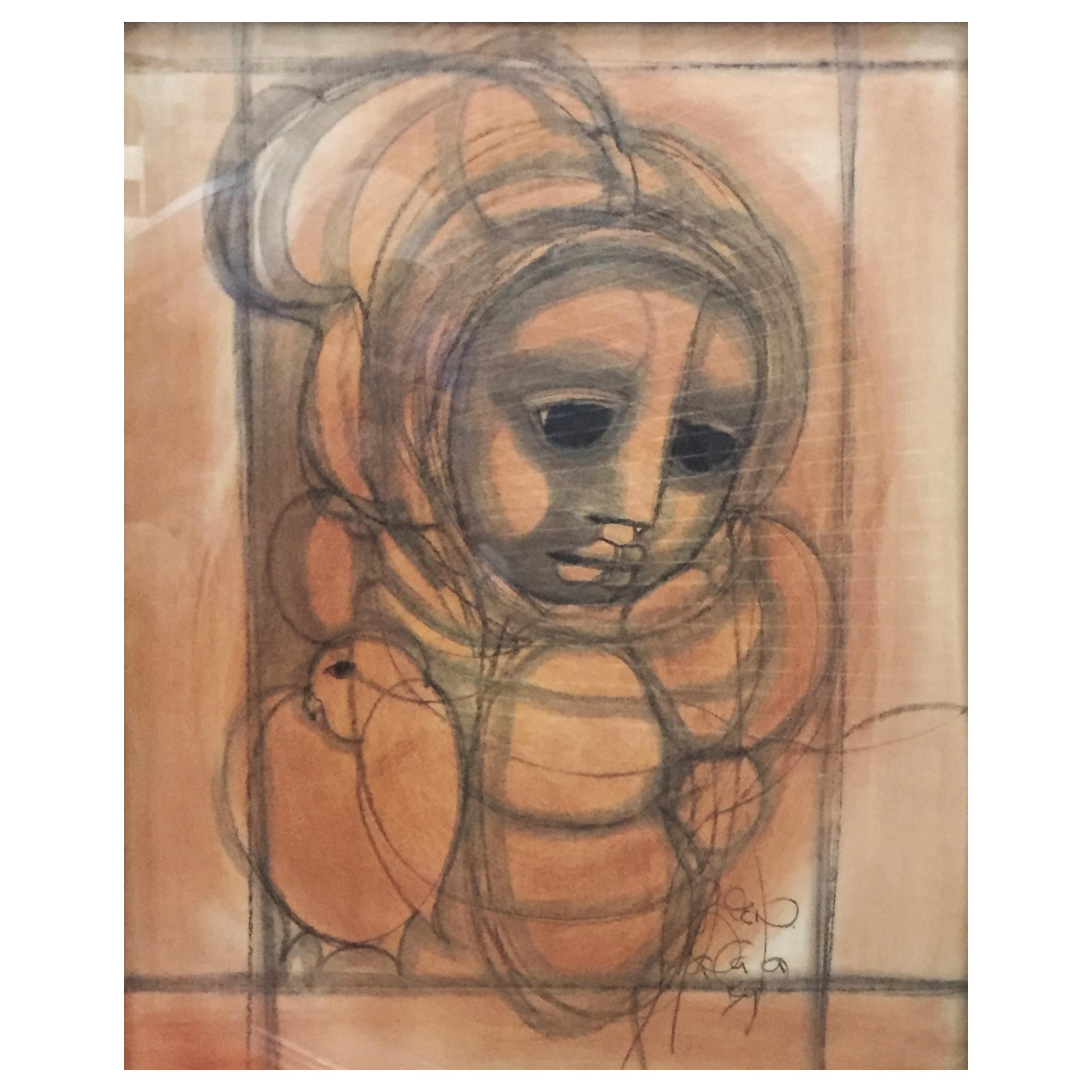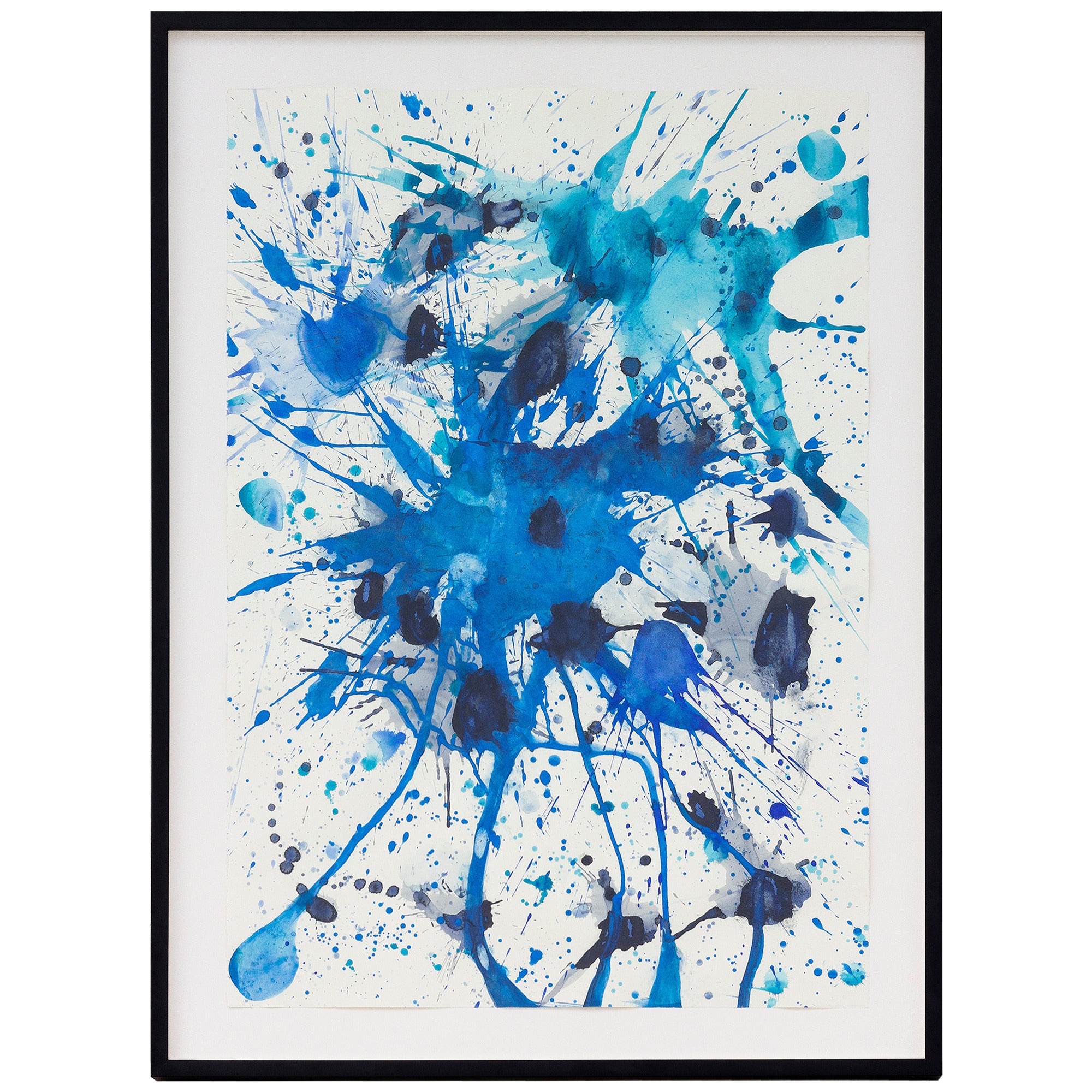Items Similar to Boris Solotareff, Double-Portrait, Watercolor and Gouache on Paper, 1920s
Want more images or videos?
Request additional images or videos from the seller
1 of 6
Boris Solotareff, Double-Portrait, Watercolor and Gouache on Paper, 1920s
About the Item
Boris Solotareff (Russian, 1889-1966) was a Russian painter, who was active in Switzerland and France; but spent the majority of his career in New York City, where he became a naturalized American citizen in 1949.
Solotareff made use of a variety of styles; according to the Benezit Dictionary of Artists, his "work was in the mainstream of Eastern European Expressionism, with influences of Art Deco from the time when he lived in Paris."
Solotareff's paintings have been exhibited widely, including the "Cinquantenaire Du Symbolisme" exhibition at the Bibliothèque Nationale (Paris, 1936), the Vendome Galleries (New York City, 1938), and the "Exhibition of oils and water colors" at the Charles Barzansky Galleries (New York City, 1940).
- Creator:Boris Solotareff (Painter)
- Dimensions:Height: 15.75 in (40.01 cm)Width: 23.5 in (59.69 cm)Depth: 1.5 in (3.81 cm)
- Style:Art Deco (Of the Period)
- Materials and Techniques:
- Place of Origin:
- Period:
- Date of Manufacture:1920s
- Condition:Wear consistent with age and use. We make our best effort to provide a fair and descriptive condition report. Please examine the photos attentively. Send us a message to request more details or discuss price.
- Seller Location:New York, NY
- Reference Number:1stDibs: LU2819311033273
About the Seller
5.0
Vetted Seller
These experienced sellers undergo a comprehensive evaluation by our team of in-house experts.
Established in 1993
1stDibs seller since 2017
68 sales on 1stDibs
Typical response time: 2 hours
- ShippingRetrieving quote...Ships From: New York, NY
- Return PolicyA return for this item may be initiated within 10 days of delivery.
More From This SellerView All
- Boris Solotareff, Portrait of Mr. Lautenberg, Oil on Canvas Painting, 1920sBy Boris SolotareffLocated in New York, NYSigned en verso B. Solotareff, Lautenberg. Original period frame, made personally by the artist. Dimensions (without frame): Height 16” Width 12 ½”. Dimensions (with frame...Category
Vintage 1920s French Art Deco Paintings
MaterialsCanvas
- Girl and Bird, Original Watercolor, Gouache and Pencil on Paper, 1960sLocated in New York, NYA wonderful work of Mid-Century Modern art, framed. Artist’s signature is illegible Dimensions: Painting (only): 25 x 19.75 inches Painting (framed): 26 x 20.75 inches.Category
Vintage 1960s American Mid-Century Modern Paintings
MaterialsPaper
- Irina Shtenberg, Portrait of a Young Woman, Watercolor on Paper, circa 1940sLocated in New York, NYUnsigned. Attributed to Irina Valeryanovna Shtenberg. Period frame. Dimensions (unframed): Height: 13”, width: 11” Dimensions (framed): Height: 15”, width: 12-7/8” All the w...Category
Vintage 1940s Russian Mid-Century Modern Paintings
MaterialsPaper
- David Anthony Tauszky, Portrait of a Chinese Woman, American Art Deco, ca. 1920sLocated in New York, NYDimensions: Height: 24” (61cm) Width: 20” (50.8cm) Frame width: 3.25” (8.12 cm) About: This very elegant painting is a part of the famous ‘Cantonese’ series of mainly female portraits, painter by David Anthony Tauszky...Category
Vintage 1920s American Art Deco Paintings
MaterialsPaint
- Emmanuel Fougerat, O/C Portrait of La Argentinita, ca. 1920By Emmanuel FougeratLocated in New York, NYDIMENSIONS: Height: 16.25 inches Width: 13.5 inches Depth: 2.25 inches Frame width: 2.5 inches ABOUT MODEL Encarnación López Júlvez, known as La Argentinita (Buenos Aires, March 3, 1898 – New York, September 24, 1945) was a Spanish-Argentine flamenco dancer (bailaora), choreographer and singer. La Argentinita was considered the highest expression of this art form during that time. López Júlvez was the daughter of Spanish immigrants in Argentina, where her father had a fabric business. While living there, two of her siblings died in a scarlet fever epidemic. Consequently, she was brought to the north coast of Spain in 1901, where she began to learn Spanish regional dances. When she was only four years old, she started learning flamenco from Julia Castelao. Her first public performance was at the age of eight at the Teatro-Circo de San Sebastián, in the Basque Country. She chose the name "La Argentinita" in deference to the famous flamenco dancer Antonia Mercé (La Argentina). After travelling throughout Spain as a child prodigy, she settled in Madrid to perform at Teatro La Latina, Teatro de la Comedia, Teatro de La Princesa, Teatro Apolo and Teatro Príncipe Alfonso. Her success led her to tour in Barcelona, Portugal and Paris, and then Latin America. In the early 1920s, she returned to Spain, where she worked in Madrid. Among her early performances was the 1920 premiere of Federico García Lorca's musical play El maleficio de la mariposa as "the Butterfly". She announced her retirement in 1926, but would quickly return to the show business as part of the artistic renewal that led her to the Generation of ‘27, in which she combined flamenco, tango, bulerías and boleros. She danced to the compositions of Manuel de Falla, Joaquín Turina, Isaac Albéniz, Enrique Granados and Maurice Ravel. She helped in the development of Ballet Español. Adapting pieces to popular tradition, she toured Europe, triumphing in Paris and Berlin and participating in the artistic movements of that time along with Spanish poets such as Rafael Alberti, Federico García Lorca, Edgar Neville and Ignacio Sanchez Mejias. Sánchez Mejías, an intellectual and bullfighter, was a married man and her lover. La Argentinita retired a second time to maintain her clandestine relationship with him. However, she would return to the stage with the aid of Sánchez Mejías, who participated in the search and employment of interpreters for her subsequent performances. In 1931, López Júlvez and García Lorca recorded five gramophone slate records, which were accompanied by García Lorca's piano. The selection of songs was prepared, adapted and titled Colección de Canciones Populares Españolas by García Lorca. Among the ten songs were "Los cuatro muleros", "Zorongo gitano", "Anda Jaleo" and "En el Café de Chinitas". With the beginning of the Second Spanish Republic, López Júlvez formed her own ballet company called Bailes Españoles de la Argentinita together with her sister, Pilar López Júlvez, and García Lorca. López Júlvez staged several flamenco theatrical shows, including an adaption of Falla's El amor brujo (Love, the Magician) in 1933, and Las Calles de Cádiz (The Streets of Cadiz) in 1933 and 1940.[7] She travelled through Spain and Paris, where she was recognized as one of the most important flamenco artists of her time. Her company included the flamenco figures Juana la Macarrona, La Malena, Fernanda Antúnez, Rafael Ortega and Antonio de Triana, who was her first dancing partner until the 1940s. At the end of her tour around Spain, her lover Sánchez Mejías was gored to death in 1934 in the Manzanares bullring. She sought refuge in her work and moved to Buenos Aires to dance at the Teatro Colón; from there she embarked on a long American tour. In 1936 she achieved success in New York. Afterwards, she returned to Spain but was forced to flee the country shortly before the outbreak of the Spanish Civil War. She travelled through Morocco, France, the UK, the Netherlands, Belgium and the USA, where she remained in exile in New York. From then until her death in 1945, she developed her career and became one of the biggest stars of international dance, and even participated in movies. In 1943, she presented the flamenco troupe El Café de Chinitas at the Metropolitan Opera House in New York, with her own choreography, texts by García Lorca, scenery by Salvador Dalí and the orchestra directed by José Iturbi. In addition, she performed at the Washington DC Watergate complex with her sister. On May 28, 1945, she gave her last performance at the Metropolitan of the orchestral work El Capricho Español, composed in 1887 by Nikolai Rimsky-Korsakov and based on Spanish melodies. At the end of the event, she had to be admitted to a hospital, where she died on September 24 from a tumor in her abdomen. She did not want to have it operated on because she did not wish to abandon dancing. Her body was repatriated to Spain in December and buried in the Spanish capital. That same year, the company of Bailes Españoles de la Argentinita was dissolved. Among the honors she received after her death was a plaque consecrated at the Metropolitan Opera House, positioned among the medals of Alfonso X El Sabio and La Orden de Isabel la Católica to honor her merits in the field of culture. ABOUT ARTIST Emmanuel Fougerat (French, 1869 – 1958) was a renowned French painter, museum curator and art historian. A former student of the Regional School of Fine Arts in Rennes, Fougerat studied in the studio of Albert Maignan and that of Jean-Paul Laurens in Paris. He was appointed director of the Nantes School of Fine Arts and was also the founder and curator of the Museum of Fine Arts in the same city. Emmanuel Fougerat was named Chevalier of the Legion of Honor in 1912. In 1923, he was placed on temporary leave from the French State in order to carry out a mandate as director of fine arts education in the Province of Quebec, Canada; where he served as an art teacher and director of the École des beaux-arts de Montréal from 1923 to 1925. Emmanuel Fougerat’s paintings are in the following public collections: • Nantes Museum of Fine Arts, France. • Museum of Modern Art in Paris, France. • Rennes Town Hall: permanent decorations. • Museum of Fine Arts of Saint-Nazaire (destroyed in 1944), France • National Museum of Fine Arts of Quebec, Canada. Emmanuel Fougerat is also the author of works on several French painters, including Albert Besnard, Paul Baudry...Category
Vintage 1920s French Art Deco Paintings
MaterialsCanvas
- Rolph Scarlett, Modernist Abstract Composition, Guache on Paper, Ca. 1950’sBy Rolph ScarlettLocated in New York, NYArtist: Rolph Scarletti (Canadian, 1889 – 1984) Object: Modernist Abstract Composition Period: Ca. 1950’s Medium: Guache on paper, framed Dimensions (unframed): Height: 9-1/3” Width: 12” Dimensions (framed): Height: 22-3/4”” Width: 25-3/4” Rolph Scarlett (Canadian, 1889 – 1984) was a consummate explorer of twentieth-century abstract painting. Never afraid of trying new styles, curious and opinionated, constantly engaged with the world around him while steadfastly aware that he was on his own path and his alone, Scarlett more than once proved to be at the artistic zeitgeist of the eras in which he lived. Exposed very early on to the work of Paul Klee through a chance meeting in Europe with the artist himself, Scarlett took up abstraction with a fervor that never diminished during his long and impressive career. To create something that had never existed before: this was Scarlett’s great cause. And that is what is most obvious when you look at Scarlett’s work—you have never seen anything quite like it. Scarlett was Canadian-born, came of age in the Midwest, and spent few important years in Hollywood, where he designed stage sets. His work from this early period echoes Klee’s use of color, his confidence in naïve, primitive forms, and his blend of abstraction and figuration. In its flat spatial qualities it prefigures the Indian Space painting of the 1940s by a decade. He moved to New York in 1933 and eventually found his first great patron at the Museum of Non-Objective Painting, directed by Baroness Hilla Rebay and art patron Solomon R. Guggenheim. Guggenheim would collect over 60 works by Scarlett for his collection, more than any other artist outside of Vasily Kandinsky and Rudolf Bauer. As a frequent exhibitor and lecturer at the Museum of Non-Objective Painting (MNOP), Scarlett honed his sensitive feel for bodies in space and capitalized on his trademark use of bright, vivacious colors into accomplished, perfectly harmonized geometric works. However, Scarlett soon morphed these hard-edged forms into a nuanced expressionistic abstraction which, at its best, seems to be populated by dancing forms that animate the canvases. Along this way he was advised by Rudolf Bauer, the German expatriate and one of the originators of non-objective painting in the teens. Bauer had the idea for the Museum, and Rebay, his champion, had found in Solomon Guggenheim a patron for manifesting it. When Bauer emigrated just before World War II, he wanted to meet Scarlett. The two became friends, and Bauer advised Scarlett on his work over the course of many years. Even in a 1979 interview, Scarlett began to tear up as he recalled his first meeting with Bauer, a man whose work he "worshipped," describing that, "It was a touching moment for me, I’ll tell you." Scarlett and Rebay also had a close, important relationship, one in which he bore the brunt of her sometimes condescending, if motherly, critiques and admonitions with tolerance and gratefulness. Eventually, though, he had to push back. In a letter from 1951 he writes, "I have noticed with growing amazement that during the past three years you have accepted less and less of my work—and, that same work, which you rejected has been accepted and shown in the best and largest shows all over this country." This period—the late 1940s to the early 1950s—did in fact correspond to Scarlett’s most critical success, and to a return to the fanciful forms and characters of his pre-war work. At the same time, he found his own rhythm and complexity using a drip style similar to, though denser and more opaque than, the one made famous by Jackson Pollock, who had worked for many years at the MNOP and with whom he shared common influences. In 1949 he had a very well received solo show in 1949 at the Jacques Seligmann Gallery, reviewed very favorably in The New York Times: "The impression made by these paintings is one of originality and strength." He was also included in a juried show "American Painting Today" at the Metropolitan Museum of Art in 1950 and in the Whitney Annual of 1951. The curator for the Whitney show in fact bypassed a selection of Scarlett’s careful geometrics in favor of a new "lyrical" drip painting—one which he describes as having had "a helluva good time" making. Rebay articulated her loss of control over Scarlett very keenly in one of her last official letters to him: "So your way ended in the horrid jungle it is in now; even a Mr. Pollock’s smearage was not bad enough for you to have a try at; and betraying yourself, you betrayed art and my faith in you, and my present disgrace by my failure to foresee such an outrageous possibility—since you even paint objectively now." Yet, despite the fact that he was moving in his own direction when the change in leadership took place at the Museum of Non-Objective Painting and Rebay was forced out as director, Scarlett was hit hard. He understood this change rightly as a betrayal by the establishment. Scarlett was a unique individual and soul, and was affected personally and philosophically by the idea that the movement with which Scarlett had aligned his talents seemed to disappear overnight, and his life’s work rendered valueless. Without the Museum’s support, Scarlett decided eventually to move to the artists’ community of Shady, New York, just outside of Woodstock. He had occasional shows throughout the years, but mostly settled down to regional obscurity. He began making jewelry, which had been his first trade, and it was following a show of his jewelry in 1975 at the Jaro Gallery, that he was rediscovered by Samuel Esses, and his wife Sandy. Samuel Esses was a successful businessman and an avid collector. He always sought out that which was unusual and, like Scarlett, was ahead of his time in many ways. For example, in 1979, Sam became enthralled with the early graffiti appearing on the New York subway trains. With the sole goal of preserving these groundbreaking yet short lived works of art he was inspired to create "The Esses Studio," a painting warehouse and workshop for graffiti artists to work in a studio, collaborate, and paint on canvas. The biggest names of graffiti writing participated—Futura, Crash, Dondi, Zephyr, and Daze to name a few. The project was well received and provided critical validation at an important time for this alternative form of abstraction to be recognized by the established art world. The success of the "Esses Studio" helped fuel an alternative fire that would propel gallerists and curators to acknowledge other street artists and provide a foundation of acceptance for the early careers of Keith Haring and Jean-Michel Basquiat. It is not a stretch to say that what Esses saw in the graffiti art of the 1970s was very similar to what he saw in 1950s-era Scarletts—something raw, honest, and melding many twentieth century influences into one unique form. Inspired by the importance of the collection and the passion of the collector, Weinstein Gallery...Category
Vintage 1950s Canadian Mid-Century Modern Paintings
MaterialsPaper
You May Also Like
- "Nudes in Landscape, " Watercolor Painting by SolotareffBy Boris SolotareffLocated in Philadelphia, PARich with color and evocative of a woodland setting with nude Classical figures, this lovely watercolor painting was made by Boris Solotareff in 1928, in Paris. The artist was born ...Category
Early 20th Century French Paintings
MaterialsWatercolor, Paper
- "Cherubs" Gouache and Watercolor on PaperLocated in West Palm Beach, FLContinental school, 19th-20th century "Cherubs" Gouache and Watercolor on paper Size with frame: 19 x 11 in. (48.26 x 27.94 cm.)Category
Vintage 1950s Drawings
MaterialsPaper
- Manfredo Borsi, Italian Artist, Watercolor and Gouache on Paper, GiraffeLocated in Copenhagen, DKManfredo Borsi (1900-1967), Italian artist. Watercolor and gouache on paper. Giraffe. Dated 1957. The paper measures: 64 x 49 cm. In excellent condition. Signed and dated.Category
Vintage 1950s Italian Modern Paintings
MaterialsOther
- J. Steven Manolis Abstract Gouache and Watercolor on Paper, 2007, USABy J. Steven ManolisLocated in Miami, FLBeautiful abstract framed Gouache and watercolor on paper piece entitled Splash 2007.10 2007, USA. Framed measurement: 57" x 45". About the artist. “My objective is to mak...Category
Early 2000s American Modern Paintings
MaterialsWatercolor
- Gouache on PaperLocated in West Palm Beach, FLThis stylish and chic 1930s gouache on paper by Kapur depicts a "Latin Lover" in all of his glory as he is surrounded by a lush, tropical garden as he...Category
Mid-20th Century Argentine Mid-Century Modern Paintings
MaterialsPaper
- Emile Jean Patoux, Belgian Artist, Watercolor, Gouache on PaperLocated in Copenhagen, DKEmile Jean Patoux (1893-1985), listed Belgian artist. Watercolor and gouache on paper. Floral motif. Mid-20th century. The paper measures: 65 x 61 cm. The frame measures: 4.5 cm....Category
Mid-20th Century Belgian Modern Paintings
MaterialsOther
Recently Viewed
View AllMore Ways To Browse
Deco Gouache
1920s French Art Deco Painting
Vendome Furniture
Eastern European Painted Furniture
Painted Bibliotheque
Painted French Bibliotheque
Oils 1920s
Antique Oil On Canvas Italy
Antique Italian Oil On Canvas
Antique White Paint On Walls
Antique Wall Pictures
Vintage Wall Street Sign
Oriental Decorations
Italian Period Paintings
Vintage Furniture Connecticut
Wall Panels Red
18th Century England Painting
Gold Gilt Frame Paintings





